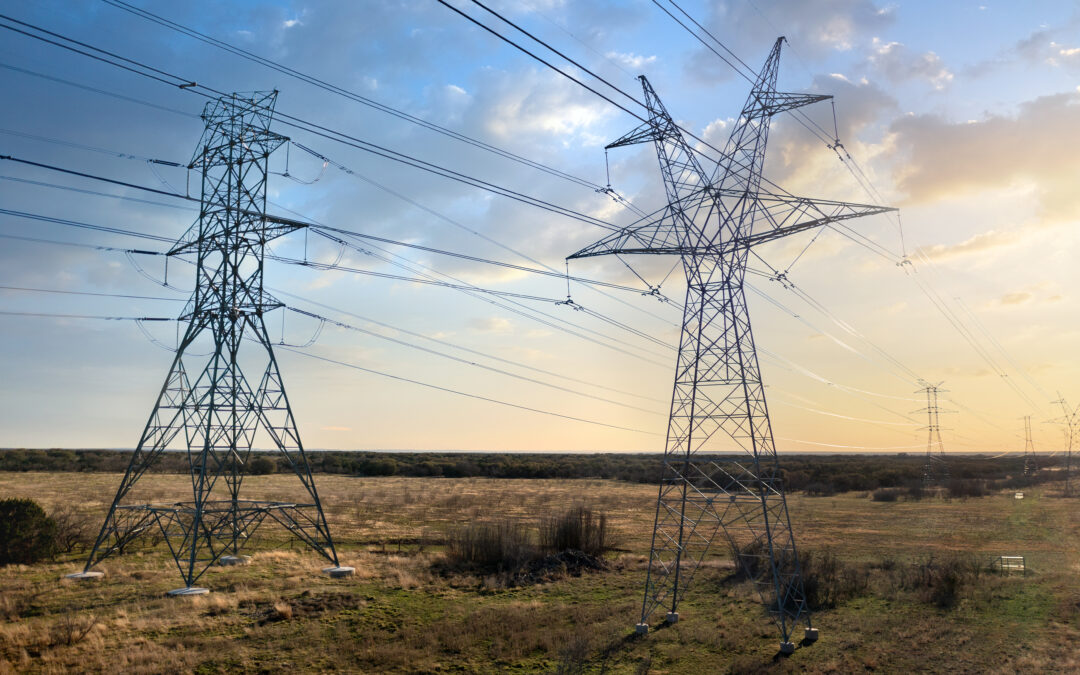By Sheldon Kimber, CEO, Intersect Power
A Broken Power Grid and An Industry Waiting To Be Saved
There is an oft cited story that my dad used in his Sunday morning sermons, where an elderly man is trapped in his home during a flood. A group of rescuers ask if they can escort him to safety, but he declines, stating God will save him. Hours later the flood waters have reached his second floor, and rescuers in a boat offer him a ride to higher ground, but again, he declines, resolute that God will save him. Finally, the risen waters force him to the roof where rescuers in a helicopter offer to deliver him to safety, but he declines a third time, telling them God has a plan for his security. The man eventually succumbs to the water and finds himself in heaven. He says, Lord I have done all you ask with my life, but when I prayed for you to deliver me from the flood you left me to die. God says to him, don’t blame me, I sent you a group of rescuers on foot, a boat, and a helicopter!
The Current State of Our U.S. Power Grid
In some ways, the electric power industry is behaving like the man in the story. We are waiting for a savior to pluck us from the quagmire of overloaded interconnection queues and lack of transmission capacity, convinced that help is on the way and betting our companies and livelihoods on such an outcome.
The reality is our U.S. power grid has added a limited number of miles (1% per year[1]) of new transmission from 2013 to 2020. By contrast, the U.S. currently has 1,529 miles[2] of high voltage direct current lines laid and 2.6 million miles of pipelines capable of carrying “trillions of cubic feet of natural gas transporting hundreds of billions of ton/miles of liquid petroleum products each year”.[3] U.S. companies have also committed over $200 billion dollars[4] to build new manufacturing projects, with industrial facilities spending nearly $125 billion on energy every year.[5] The numbers don’t lie, electric transmission is a uniquely hard form of infrastructure to develop and construct in this country, and no equivalent of the Eisenhower freeway system is coming to save the lines in this country.
The Heart of the Issue
The balkanization of our power grid is due to a patchwork of state and regional regulations combined with the natural tension between regulated utilities sensitive to impacts on their specific rate payers and developers eager to provide transmission solutions that create value for the system overall. These are some of the longest standing and most entrenched political and commercial interests in the country, and none of this is likely to change anytime soon. I wrote another piece on this a few years ago, which you can find here.[6]
If by some miracle progress is made, and every major thttps://www.intersectpower.com/the-intersection-blog/software-is-eating-the-world-but-steel-is-in-the-hardware-it-runs-on/ransmission project proposed today were built, the impact would still only be a small part of what is needed to meet our climate goals. To help integrate renewable energy sources and meet our climate goals, we’ll need to expand transmission systems 60% by 2030 and triple those systems by 2050.[7] In general, it would allow for less battery storage to be needed to balance West Coast solar, get more wind generation into the MISO and PJM, and open up constraints in specific regions, but it wouldn’t allow for the hundreds of GWs of generation that need to get built for green hydrogen to be grid tied, AI data centers to be located in Virginia, and electric vehicles and heat pumps to dominate.
Thinking Outside the Grid
There are pockets of abundant, cheap, clean electricity across the country that have no means of being delivered over the power grid. At the same time, the U.S. is “reindustrializing” with more manufacturing capacity, including adding 367,000 manufacturing jobs in 2022 – the most in nearly 30 years – and outpacing the rest of the world’s growth for the first time at the end of last year.[8] This is before we get to the new loads that will come from industries that are still nascent or don’t exist today, such as data centers, clean hydrogen production, direct air capture, and desalination. Ultimately the cheap, clean energy that cannot be transported as electrons will be moved as photons, green molecules, clean water, green steel, and other industrial outputs. This is the new transmission.
Much of the new load that locates at the point of generation will be built behind the meter and won’t interconnect to the grid or will only do so for purposes of backup. It will be the developers and owners of these massive lowest LCOE, highest capacity factor renewable energy resources that benefit from this transition. Take for example the green hydrogen business. With almost 80% of the capex coming from renewables, saying that you are a “green hydrogen developer” rings hollow if you are not one of the largest renewables developers. With this sort of head start, shame on the renewables industry if we wind up as the commodity provider of green electrons to grid tied electrolyzer operators creating even more grid congestion and dysfunction. It’s worth finding ways to deploy hydrogen and related infrastructure, alongside the traditional electric grid to save money at the system level.[9] Researchers at Technische Universität Berlin say a hydrogen network connecting regions with low-cost renewable potential to demand centers, electrofuel production, and cavern storage sites in Europe could reduce system costs by up to $29.2 billion a year. I am confident this is also applicable to the United States.
Real Life Example: Data Centers
If you doubt this analysis, I encourage you to take a look at the existing data center industry – and its meteoric growth. In fact, the U.S. accounts for about 40% of the global data center market, and demand in the country is forecasted to grow by around 10% a year until 2030.[10] Today’s data centers have perhaps the fastest growth in energy use of any industry since the Industrial Revolution, but there’s now a focus on the rapidly emerging constraint to this growth that energy represents. To date, the industry has found focal points in places where the key inputs that were in shortest supply – an expert labor market, low latency fiber connections, and other non-energy siting constraints – were available and in some cases abundant. These locations were mainly urban centers where energy solutions were happily provided by utilities who hadn’t seen significant load growth in decades, places like Northern Virginia, Santa Clara, Dallas, and Las Vegas.
As the industry has scaled, these loads have begun to get more challenging to serve. Other growth opportunities exist in most urban utilities today in the residential and smaller commercial side of their businesses through electrification, EVs, and demand side management efforts now incentivized by public utility commissions. The appeal of taking on new tens of MW or even hundreds of MW load interconnections for data centers, which demand 24×7 green power solutions and often require new transmission and upgrades seems to have waned. Moreover, while you may be able to technically get a load interconnection of this scale in an urban area, such as Dallas, the prospect of either directly or managing the price risk through a service provider of both energy and RECs in a highly constrained ERCOT grid environment should be daunting to all but the most experienced participants in those markets. All this is taking place in an industry with much higher margins than most industrial applications, meaning these issues are likely to be far more challenging should they be grid tied going forward.
What’s Next?
The result of this shifting paradigm in the generation and delivery of clean energy will disrupt the economics of many existing industries and define economics for future industries. But the impact will not just be economic. The U.S. industrial growth of the 20th century redefined entire regions of this country often creating huge hubs of economic activity around natural resources, energy, and transportation corridors. The failure of today’s power grid and the growing requirements for high-capacity factor, low carbon energy may do the same. The potential for rural economic development and the revitalization of communities whose income has suffered due to loss of agricultural or fossil fuel industries will be significant. Hopefully, these changes can once and for all delink the growth of clean energy from today’s political partisanship and ensure that all Americans benefit from the energy transition.
Clearly our industry faces the threat of a rising flood of interconnection and transmission problems. I am convinced that it will be the developers and owners who embrace this relocation of large loads closer to generation who succeed at scale. We must learn new industries, partner more deeply with large energy users, educate financing counterparties, build more creative offtake structures, and optimize our physical designs in order to facilitate these new business models. Perhaps the lifeboats provided by these new loads relocating closer to the point of generation will not be enough, but at Intersect Power we’re not waiting around to see how high the floodwaters get.
[1] Why it’s so hard to build new electrical transmission lines in the U.S. https://www.cnbc.com/2023/02/21/why-its-so-hard-to-build-new-electrical-transmission-lines-in-the-us.html
[2] The US is laying new power lines too slowly for its renewables transition. https://qz.com/the-us-is-laying-new-power-lines-too-slowly-for-its-ren-1850326951
[3] General Pipeline FAQs. https://www.phmsa.dot.gov/faqs/general-pipeline-faqs#:~:text=The%20nation’s%20more%20than%202.6,of%20other%20forms%20of%20transportation.
[4] US manufacturing commitments double after Biden subsidies launched. https://www.ft.com/content/b1079606-5543-4fc5-acae-2c6c84b3a49f
[5] Energy Savings Tips for Small Businesses: Small and Medium Manufacturers. https://www.energystar.gov/buildings/resources_audience/small_biz/small_medium_manufacturers
[6] Software Is Eating The World, But Steel Is The Hardware It Runs On: A Reply To Marc Andreessen’s “It’s Time To Build”. https://www.intersectpower.com/the-intersection-blog/software-is-eating-the-world-but-steel-is-in-the-hardware-it-runs-on/
[7] Queued Up… But in Need of Transmission. https://www.energy.gov/policy/queued-need-transmission
[8] The Biden- Harris Plan to Revitalize American Manufacturing and Secure Critical Supply Chains in 2022. https://www.whitehouse.gov/briefing-room/statements-releases/2022/02/24/the-biden-harris-plan-to-revitalize-american-manufacturing-and-secure-critical-supply-chains-in-2022/
[9] The Potential Role of a Hydrogen Network in Europe. https://www.sciencedirect.com/science/article/pii/S2542435123002660
[10] Investing in the rising data center economy. https://www.mckinsey.com/industries/technology-media-and-telecommunications/our-insights/investing-in-the-rising-data-center-economy

